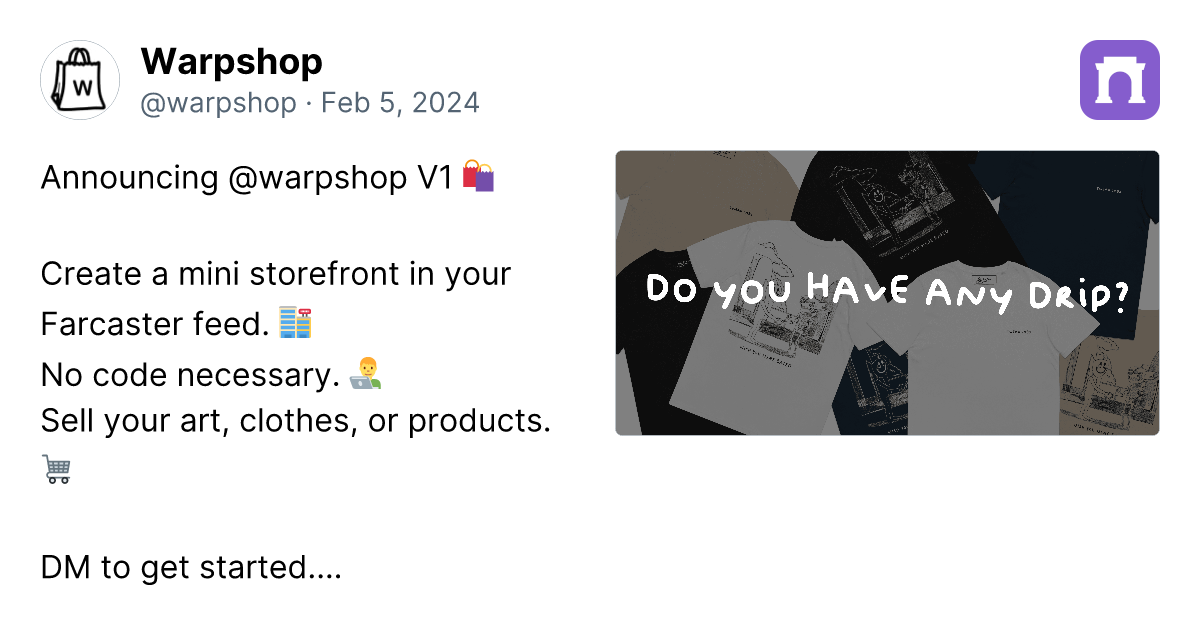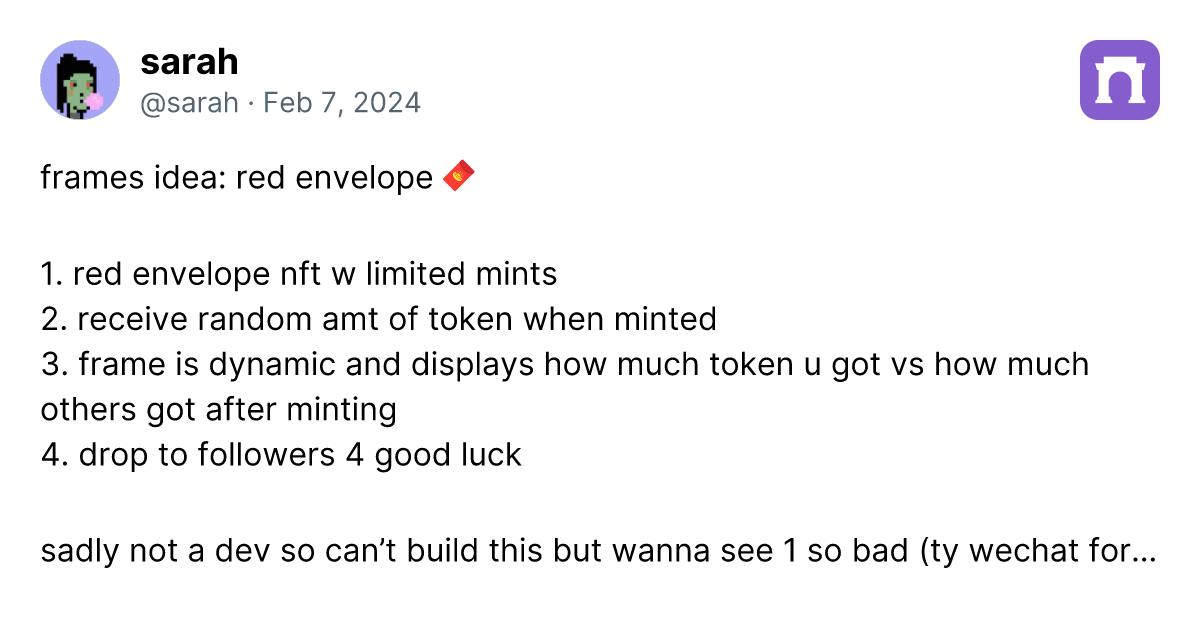Farcaster: The superapp social layer
What makes a superapp a superapp, and why most crypto apps just aren't there yet—until Farcaster

Growing up in China, I spent a good amount of years on WeChat. It’s frequently cited as the prime example of a “superapp”: a single application consisting of multiple mini-programs and mini-apps that span from digital payments services to booking your next hair appointment. In terms of convenience and access, it’s an unparalleled UX that I rarely see in non-Chinese apps and products.
An example of how this would typically work in practice is that I could ask someone in a 500-person group chat if they wanted cookies, order cookies from the local bakery by clicking into that bakery's mini-app, and then request money from everyone who wanted in on the cookie order, not just without leaving the app, but without leaving the group chat. Elon has previously reiterated his vision for Twitter as a superapp; in web3, numerous DeFi protocols and products are all simultaneously competing to become the next gateway superapp for crypto-natives and “mass adoptees” alike.
After the release of Farcaster Frames, I’m more convinced than ever that Farcaster is the crypto superapp.

That’s because Frames and Farcaster are both not necessarily novel concepts. And I don’t mean this as a criticism; it reminds me so deeply of the mini-programs and apps that I’ve seen on WeChat since the beginning, except it’s all on a sufficiently decentralized social network that’s completely incensorable.
In other words: We’ve unlocked a way to bring the rich consumer and user experiences of superapps to people without relying on the centralized and censorship-heavy superapp model. And to take inspiration from WeChat, I think Frames aren’t just a way to build single-click interactive modules (or god forbid, ads) that allow you to take certain actions for certain decentralized products. David elucidates on a kind of similar vision in “The Proto-App Thesis,” where he sees a future where social apps look like protocols. And within these protocols, developers will be able build to interactive, on-chain modules without seeking approval of an app store; instead of one all-encompassing social app, the next wave of social "apps" will serve as framework for user-generated apps, or a so-called metaapp (David has reiterated to me that we're not quite there yet with Farcaster, since it still operates within the constraints of the App Store to function).
This isn’t to say that other crypto apps haven’t tried to do the same thing. Several networks providing the infrastructure for things like cross-chain interoperability and serving products from DeFi to gaming apps have tried to frame their own product in this way, often presenting itself as a “Hub” for exploring the apps that are built on top of it—Cosmos immediately comes to mind here. I call this Iteration 1 of the crypto superapp or metaapp thesis: Create infrastructure for decentralized apps, then encourage developers to build decentralized applications on top of it to generate “composable network effects.” List your apps in a decentralized app store or database of some kind. And so on.

To move beyond this iteration, however, superapps require a social layer. WeChat can exist with its variety of mini-programs and mini-apps, but the dynamism of how these apps are shared across networks is quite literally generated within the layers and layers of social interaction that give such apps the relevant context they need for a basic user experience that makes sense. Why the fuck would I need to order cookies and request money from people if there isn’t a group chat that has the desire to eat those cookies in the first place? If I’m not using WeChat to keep in touch with family and friends, I don’t care about the apps within it; I could simply use a series of individual apps that all do their own hyper-specialized thing. But if I send an article in WeChat, I can discuss it with my friends. My dad can share irreverent cat videos using video compilation mini-apps with me in the family group chat instead of watching them on his own. My boss can take us out for dinner and split the bill using the payments feature…and so on. This social layer is what compounds in value for both builders and users over time. Similarly, I can award $DEGEN to someone on Farcaster for sending out a valuable Cast, or use Frames to vote on governance proposals and onchain actions.
Again, it’s not like other crypto apps haven’t tried to do the same thing. We’ve used Discord most often as a way to substitute for this layer, throwing around words like “community” as a thinly veiled guise for people screaming “wen token” in channels we all can’t keep up with. Crypto Twitter is basically like the modern-day equivalent of a Greek agora for the industry, where everything from in-depth scammer investigations and the intricacies of EIPs and modular blockchain theses are hashed out in Twitter threads and comments. Some protocols have tried to do, well…whatever this is.
And there are several apps pushing the envelope of true web3 social that are well on their way to becoming a crypto superapp without even realizing it. Unlonely, for example, has managed to tie together livestreaming experiences, token speculation, and long-form content all in one, while Crypto: The Game, created by a former HQ Trivia employee, has brought together citizens of Crypto Twitter to play Flappy Bird for hours on end and band together in teams to avoid elimination (and has even brought together people IRL for rides to the airport).
The social layer of crypto is what makes crypto exciting and fun. It is what makes you want to share crypto with your friends, and to instill that “a-ha!” moment in others, enabling them to finally create a MetaMask so that they, too, can explore the decentralized world of on-chain games and experiences. This is the layer that creates true network effects like any web2 consumer app that has come before it; and the more we realize that, the more we can build compelling things that not only have some sort of utility or purpose, but exist in a social context in which that utility is actually in demand.
So how does Farcaster fit into the picture? Since the release of Frames, we’ve already seen some early indications that Farcaster provides the necessary social context for the apps built within Frames to exist. In just less than two weeks, someone has already built a Shopify for Frames, which has probably made a few VC dreams of "social commerce" unknowingly come true. Dan has done the difficult task of slowly and intentionally curating an extended social network of Ethereum-aligned builders and operators to exist in a shared context, a sociologically-necessary component of how humans form bonds and relationships with each other.
Like I’ve mentioned above, we’ve seen some early waves of how Frames can necessarily connect this rich social context to the utility of apps and products that are being rapidly built in crypto. I’ve proposed a Frames idea that basically emulates one of the most successful WeChat mini-apps to a T: a Red Packet Frame for the Lunar New Year. And just like how you wouldn’t receive a Red Packet out of nowhere IRL, why would you want to receive a Red Packet in a vacuum online? That’s where Farcaster comes in.
I’m no developer, but the human side of this technology is something that will allow us to build amazing things that we love to share with others–and I think it’s a necessary component to what makes Farcaster so successful.
Thank you to David Phelps and Payom Dousti for feedback on this article.





 21
21



great piece by @sarah. some of my thoughts below. https://paragraph.xyz/@meowllark/farcaster-as-the-next-superapp?referrer=0x3BD4c721C1b547Ea42F728B5a19eB6233803963E
ty for a great read, I've been getting very similar vibes
what makes a superapp a superapp? and why haven't we built one in crypto yet—until Farcaster? i write about how Farcaster provides the necessary social layer for a superapp, and how we're closer than ever to building a decentralized one with Frames https://paragraph.xyz/@meowllark/farcaster-as-the-next-superapp
in sync https://warpcast.com/carlos/0xdd230d15
ayy let’s go @nir 🤝